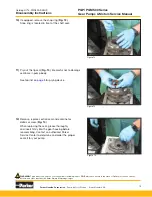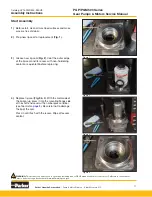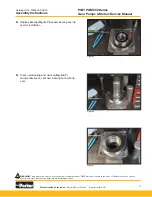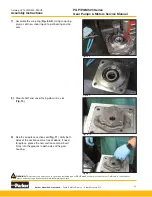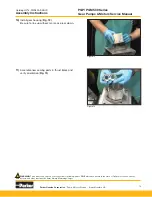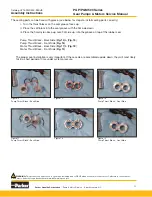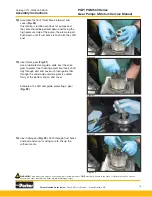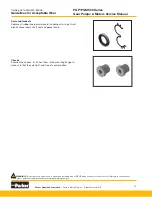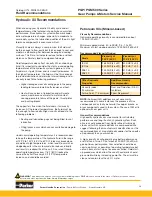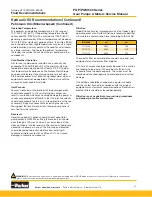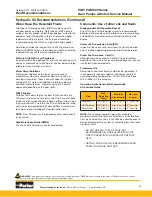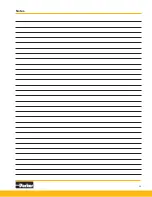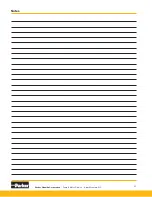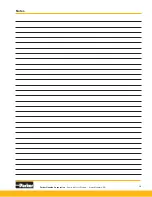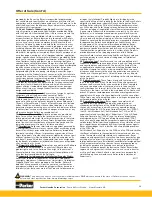
23
Parker Hannifin Corporation
|
Pump & Motor Division
|
Kings Mountain, NC
WARNING:
This product can expose you to chemicals including lead or DEHP which are known to the state of California to cause cancer,
birth defects, and other reproductive harm. www.p65warnings.ca.gov
Catalog HY13-PMD500-SM/US
PGP/PGM 500 Series
Gear Pumps & Motors Service Manual
Start-up Procedure / Test Procedure
Before installing a new or rebuilt pump, back off the main
relief valve until the spring tension on the adjusting screw
is relieved. This will avoid the possibility of immediate
damage to the replacement unit in the event that the relief
valve setting had been increased beyond the recommended
operating pressure, prior to removing the old unit.
Before connecting any lines to the pump, fill all ports with
clean oil to provide initial lubrication. This is particularly
important if the unit is located above the oil reservoir.
After connecting the lines and mounting the replacement
unit, operate the pump at least two minutes at no load and
at low rpm (400 min.) During this break-in period, the unit
should run free and not develop an excessive amount of
heat. If the unit operates properly, speed and pressure can
then be increased to normal operating settings.
Reset the main relief valve to its proper setting while the
pump is running at maximum operating engine (motor)
speed for the vehicle.
ALWAYS USE AN ACCURATE GAUGE WHEN
ADJUSTING THE RELIEF VALVE PRESSURE SETTING.
Recommended Start-up Procedure for
New or Rebuilt Pump
Make certain that there is an adequate supply of oil for
the pump; at least one gallon of oiI for each gpm of pump
capacity.
If one section of a tandem pump is being tested, make
sure that all other sections not being tested are adequately
supplied with oil. If any of the other sections run dry, or if
plugs are left in ports, serious and permanent damage will
result.
The oil should be a good quality hydraulic oil rated
at 150 SSU at 100°F, with the oil temperature held at
120°F plus or minus 50°F. (Test procedures are described in
detail in SAE handbooks; see Hydraulic Power Pump Test
Procedure, SAE J745c.)
The feed line must be of adequate size with no more than 5"
mercury vacuum adjacent to the pump inlet. As a rule, the
feed line must provide a feed flow velocity not in excess of 8
feet per second.
Feeding hot oil into a cold pump may cause the pump to
seize. Jog the pump by momentarily starting and stopping
repeatedly the driving engine or motor to gradually equalize
pump and oil temperatures.
Run the pump at least two minutes at no load and
moderate speed (not over 1500 rpm). If the pump becomes
excessively hot, shut down immediately and locate the
problem source.
Gradually increase pressure on pump, in 500 psi increments
until the desired test pressure has been reached. This
should take about five minutes.
Delivery should run close to rated catalog performance
figures, which are averaged from testing several pumps. A
5% lower reading may be used as a rated minimum if new
or relatively new parts have been used. When rebuilding the
pump with parts from the original pump, which, while worn,
appear satisfactory for reuse, a 10% or 15% lower reading
may be permitted, depending on the performance expected
from the equipment. One’s own experience will prove the
best guide here.
At test speeds other than 1800 rpm, gpm delivery will vary
almost proportionately, but the same (drop-off) figures
should be used.
Be sure to run the pump in the direction for which it was
designed and built. Driving the pump in the wrong direction
will build up pressure behind the shaft seal, damaging it and
necessitating replacement.
After completing testing procedures, the pump is ready for
installation and immediate duty operation on equipment.
Again, it must be remembered that to prevent seizure, hot oil
must not be fed into a cold pump.
Recommended Test Procedure


